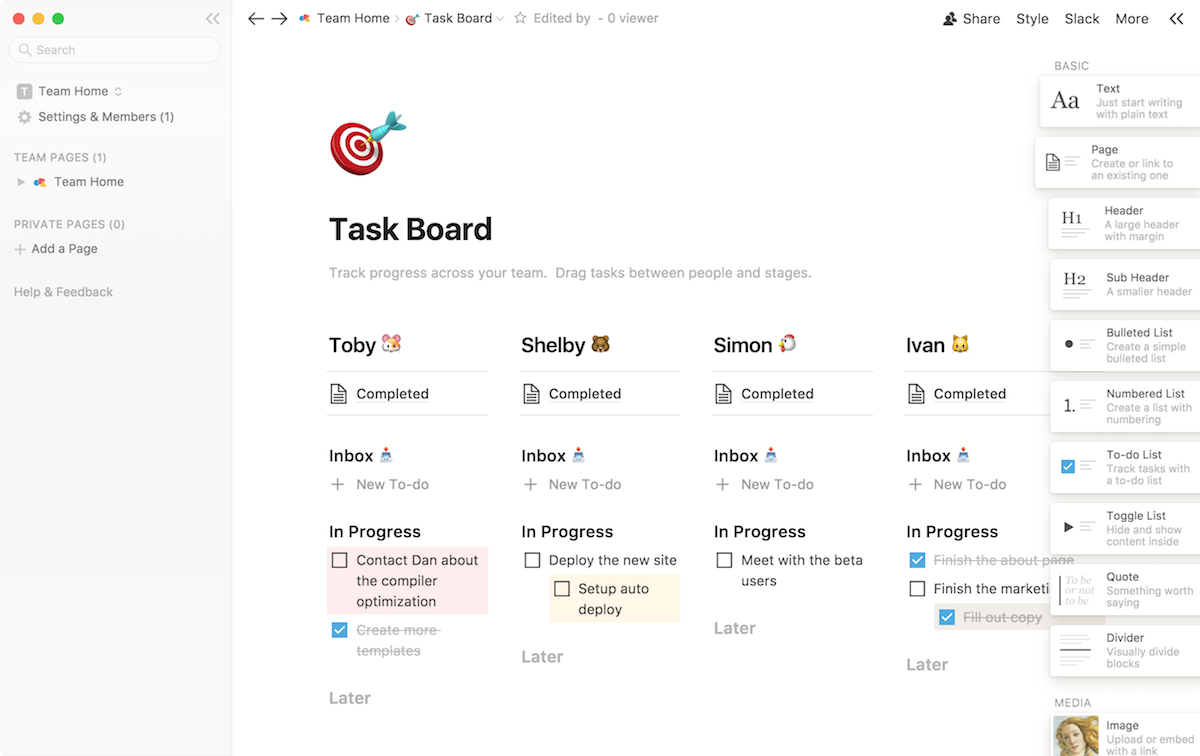Kanban In Evernote
A Kanban board is one of the tools that can be used to implement Kanban to manage work at a personal or organizational level.
PomoDuctivity - Stay Focused. Free + One Task. Drag-and-drop files onto a space or shortcut in the sidebar to add them to a space, notebook, or stack. Evernote Business customers: Published notebooks are back! Create notebooks and easily share them with your entire organization. Stability and performance.
- Kanban boards allow you to set up columns that represent a specific phase of the project cycle and use cards to represent each project. As your project advances to each phase, you move the project card from column to column until it reaches the end of the project cycle.
- Using Evernote - Creating Kanban Board view of your Notes! If playback doesn't begin shortly, try restarting your device. Videos you watch may be added to the TV's watch history and influence TV.
Kanban boards visually depict work at various stages of a process using cards to represent work items and columns to represent each stage of the process. Cards are moved from left to right to show progress and to help coordinate teams performing the work. A Kanban board may be divided into horizontal 'swimlanes' representing different kinds of work or different teams performing the work.
Kanban boards can be used in knowledge work or for manufacturing processes.[1]
Simple boards have columns for 'waiting', 'in progress' and 'completed' or 'to-do', 'doing', and 'done'. Complex Kanban boards can be created that subdivide 'in progress' work into multiple columns to visualise the flow of work across a whole value stream map.

Applications[edit]



Kanban can be used to organize many areas of an organization and can be designed accordingly. The simplest kanban board consists of three columns: 'to-do', 'doing' and 'done',[2] though some additional detail such as WiP limits are needed to fully support the Kanban Method.[3] Business functions that use kanban boards include:
- Kanban board for software development team. A popular example of a Kanban board for agile or lean software development consists of: Backlog, Ready, Coding, Testing, Approval, and Done columns. It is also a common practice to name columns in a different way, for example: Next, In Development, Done, Customer Acceptance, Live.[4]
- Kanban for marketing teams[5]
- Kanban for HR teams[6]
- Personal task management or 'Personal Kanban'[7][8]

Notable tools[edit]
- Asana, with boards
- Azure DevOps Server, an integrated ALM-platform for managing work in and across multiple teams.
- CA Technologies Rally, provides teams with the option of managing pull-based, lean software development projects.
- Evernote.
- Jira, provides kanban boards.
- Kanboard, open source Kanban-based project management software
- Microsoft Planner, a planning application available on the Microsoft Office 365 platform.
- Notion, a project management and database application includes kanban board views.
- Pivotal Tracker provides kanban boards
- Projektron BCS, project management tool, provides kanban boards for tickets and tasks
- ServiceNow platform, offers kanban style visual task boards.
- ToDoist, a web-based project management tool which added kanban board functionality in September 2020.[9]
- Trello, cards-based project management.
- Tuleap, agile open source tool for development teams: customize board columns, set WIP (Work In Progress), connect board with Issue Trackers, Git, Documents
- Twproject (formerly Teamwork), project and groupware management tool.
- Unicom Focal Point, a portfolio management and product management tool.
- Wrike, An agile collaborative work management
See also[edit]
References[edit]
- ^J. M. Gross, Kenneth R. McInnis: Kanban Made Simple—Demystifying and Applying Toyota's Legendary Manufacturing Process. Amacom, USA 2003, p. 50. ISBN0-8144-0763-3
- ^H. Kniberg, M. Skarin: Kanban and Scrum making the most of both. C4Media, Publisher of InfoQ.com, USA 2010, p. 31.
- ^Anderson, David J.; Carmichael, Andy (2016). Essential Kanban Condensed. Seattle, WA: Lean Kanban University Press. ISBN978-0-9845214-2-5.
- ^codeweavers. 'Agile Design: Kanban with our Web Designers – Design, Process Updates | Codeweavers Blog | Staffordshire Software Development House'. Codeweavers.net. Archived from the original on 1 November 2013. Retrieved 2012-08-17.
- ^J. Dager: Why you should use Kanban in Marketing?,http://business901.com/blog1/why-you-should-use-kanban-in-marketing/
- ^'Kanban for Short Intense Projects: How We Used Kanban to Visualize Our Hiring Process Workflow and Make Our Lives Easier'. Personal Kanban. 2011-01-19. Retrieved 2012-08-17.
- ^Benson, Jim, and Tonianne DeMaria Barry. Personal Kanban: Mapping Work, Navigating Life. Modus Cooperandi Press, 2011.
- ^Willeke, Marian HH. 'Agile in Academics: Applying Agile to Instructional Design.' Agile Conference (AGILE), 2011. IEEE, 2011.
- ^Sneddon, Joey (24 September 2020). 'Todoist Takes on Trello with New Kanban Board Feature'. omgubuntu.co.uk. Retrieved 22 March 2021.CS1 maint: discouraged parameter (link)
Kanban In Evernote
